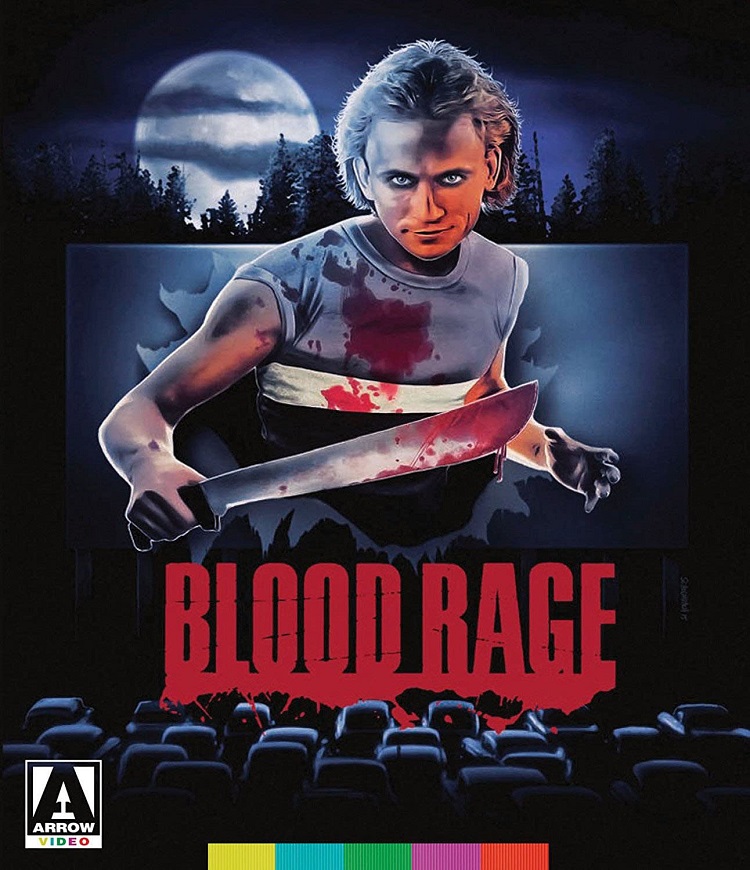
Of course the slasher genre is of an acquired taste, mainly because of the lack of unique dialogue or acting. It is really based on how characters are killed and when. Detail was placed more on blood and guts among everything else, but in 1984 (the golden age of slashers), Wes Craven’s classic Nightmare on Elm Street, became the greatest of all the ’80s bloodbaths. But after its phenomenon, the genre went into steady decline. Slasher after slasher, movies became more cheesier and less original; it was the same formula over and over again. However, Blood Rage (shot in 1983 but released in 1987) is a mixture of the good and bad. From its unexpectedly gruesome beginning to its unusually downbeat ending, it is actually an entertaining and bloody ride all the way through.
It starts in 1974 (although nothing in the opening even looks anything like the ’70s) in a drive-in where Maddy Simmons (TV icon Louise Lasser) is on a date, with her two twin sons, Teddy and Todd, sleeping in the back. While Maddy is too busy with her date, Teddy and Todd go off by themselves to pass the time, as kids often do. Teddy finds an axe in a backseat and systematically kills a guy who is having sex with his girlfriend, and then frames Todd for the murder.
Years later, while Teddy is living a normal life after college, Maddy visits Todd is a mental institution where the reunion isn’t exactly mutual. Todd immediately tries to tell Maddy that he is innocent but is then taken back to his room. During Thanksgiving dinner, Maddy tells her group of friends and Todd that she is engaged to be married, but after getting a call that Todd has escaped, her world is turned inside out and the massacre begins again.
What sets Blood Rage apart from most of the late slasher films is that there is no explanation or motive behind the killings. The nature is never revealed, but that is a good thing because that retains the underlining mystery of the story; this is where other films get it quite wrong because the reason why the killer kills is always revealed and that ruins the fun.
However, the film is no masterpiece, considering that the acting and dialogue is explicitly over-the-top, where even Lasser is all over the place. So in this case, the gore takes center stage, and there is lots of “cranberry sauce” to satisfy the most hardcore of fans. Some of the greatest kills in the film consists of the opening drive-in murder, the death of Todd’s doctor (played by producer Marianne Kanter) where she gets sliced in half, and the murder of Maddy’s finance. Even better, the great Ted Raimi has a cameo in the opening where he plays a condom seller at the drive-in, so I’m pretty sure fans will get a kick out of that.
As usual, Arrow delivers an excellent package like most of their releases, but this may just be one of their top ones, considering that there are three versions of the film: the original home video version, Nightmare at Shadow Woods (the re-edited 1987 theatrical cut), and an alternate cut combining footage from the home video version and theatrical versions.
More special features:
- Audio commentary with director John Grissmer
- Both Sides of the Camera – an interview with producer/actress Marianne Kanter, where she explains how she got involved with the film, and her gory death scene.
- Double Jeopardy – an interview with actor Mark Soper, who played both Teddy and Todd Simmons. He talks about his performance, working with Louise Lasser, and how his career changed after the film.
- Jeez, Louise! – an interview with Louise Lasser, where she talks about her early film career, and especially Mary Hartman, Mary Hartman (the series that made her a TV legend).
- Man Behind the Mayhem – an interview with special make-up effects creator Ed French (who also co-starred in the film).
- Three Minutes with Ted Raimi – a very short, but funny interview with the great Ted Raimi, where he discusses how was cast in the movie, and his life before then.
- Return to Shadow Woods – a featurette revisiting the original locations in Jacksonville, Florida. This is my favorite because you’re able to see how the locations have changed since 1983.
- Alternate opening titles with the original title, Slasher
- Motion still gallery including rare behind-the-scenes make-up effects
- Outtakes featuring rare and alternate footage
Rounding out the release is a reversible sleeve cover featuring original and new artwork by Marc Schoenbach, and a booklet with a great new essay by Joseph A. Ziemba, author of BLEEDING SKULL! A 1980s Trash-Horror Odyssey.
Overall, Blood Rage was never going to win any Oscars, but it has a huge following, and rightly so. It remains a bloody and cheesy, but fun slasher that manages to rise above other ’80s gore flicks with something to say about complex mother-and-her children relationships. As for this release, it will probably end up on many Top-10 lists of the best Blu-ray releases of the year.